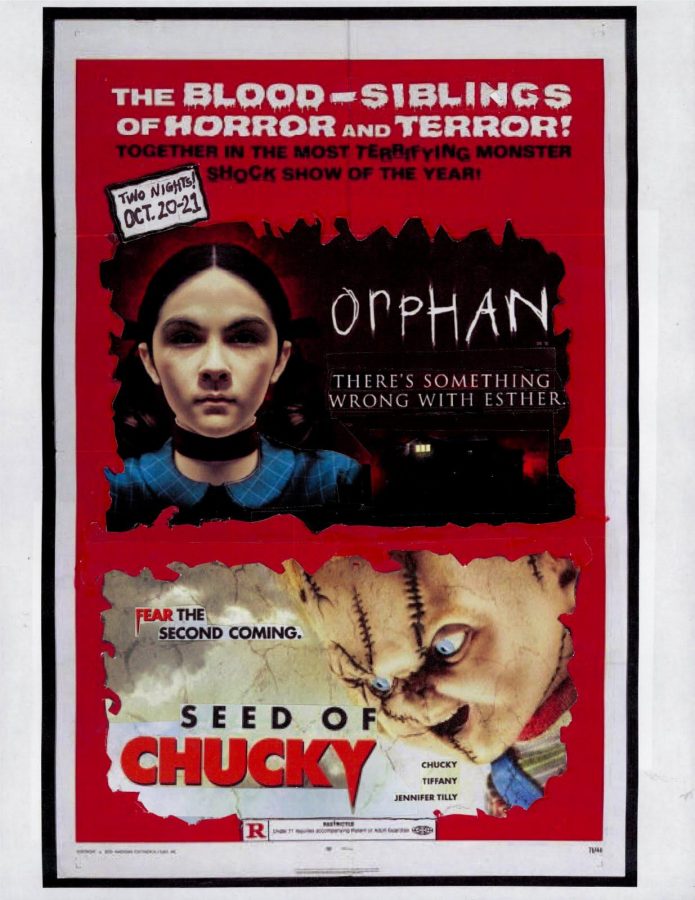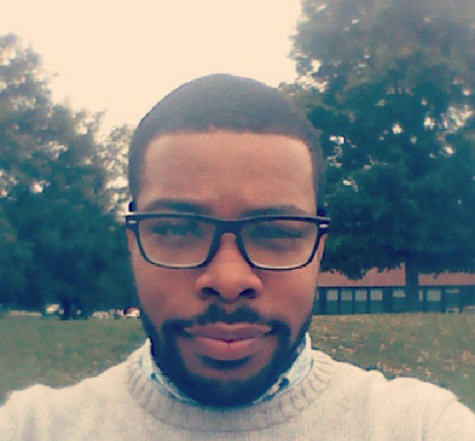Cultural Fears, Unruly Children, and the Recurring Themes in Horror Films: A Comparison of Child’s Play (1988) and Orphan (2009)
April 16, 2015
According to the Holy Bible’s story in Genesis, Chapter 4, which depicts the brutal slaying of Abel by his brother Cain, the concept of violence, in particular, murder is as old as creation. The story suggests that because of sin, the inability to control one’s emotions can lead various persons to commit certain heinous acts of violence against others, oftentimes, displaying a lack of reasoning skills. The victim was simply in the way of a goal the murderer sought out to achieve. Aside from drama films, no genre does well to depict all different types of murder for senseless reasons more than horror. Director, Tom Holland’s 1988 horror film, Child’s Play, and Director, Jaume Collet-Serra’s 2009 film Orphan, though separated by two decades of culture and cinematic progress, epitomize this idea and reflect a few common themes. Themes shared by these cultural artifacts include the “monsters’” quest to achieve, which lead them to strategic murder. The children caught in the plot are seemingly unruly, and there is a certain level of mystery and danger in regards to external forces disrupting the family unit.
Because of the rules established about classical Hollywood narrative, there is certain criteria a film must meet. One of the most pivotal elements is the “inciting incident” in which an event happens which sets the story line in order. Charles Lee Ray, a killer called “The Lakeshore Strangler”, with an appetite and insight into the inner workings of the voodoo religion, engages in a gunfight while attempting to evade law enforcement, yet receives a fatal wound. While his physical body does indeed die from the gunshot, with his last words, he utters the words “A di duey dembella, give me the power I beg of you”, enticing a certain spiritual deity, which enables him to transfer his soul into the body of a toy doll. What Ray is unaware of, in his speedy transference, is that the more time that transpires with his soul incarnate in the doll, the more mortal the doll’s body becomes. This evolution of mortality, force him to realize that if he doesn’t indeed transfer his soul into the body of the first human he revealed his secret to, hurriedly, his soul will be forever entombed in the body of the doll. Andy Barclay, a child, receives this doll for Christmas, and thus the pursuit of his soul body ensues.
While it is the monster’s ambitions which push the plot into play in Holland’s Child’s Play, The narrative of Orphan, commences in a completely different way. Early in the opening sequence of the film it is revealed, through dialogue, and camera innuendo, that Kate Coleman, a wife, and mother of three, suffers a miscarriage. In seeking to assuage her inability to conceive again, she drinks heavily. When drinking can no longer satiate her maternal longing, She and husband, John, agree that adoption would be the healthiest idea to remedy healing to their family unit. Charmed by her surface appearance, manners, and extensive vocabulary, the couple agree to adopt Esther, a thirteen year old, or so they think, orphan from Russia. Though the biological son, never warms up to Esther, the family welcomes her with open arms, until friction begins to occur between the mother and Esther. Not long after, the plot begins to unfold, and it becomes evident that there is more to this mysterious child than meets the eye.
Although typically in film, regardless of genre, the villain is the antagonist, because it is the villain whose goals are in need to be met, in these particular films, both Chucky, the monster of Child’s Play, and Esther, the genetically stunted killer in Orphan, do well to push the conventions of the genre forward by becoming the protagonists in their respective films. Though the audience is not enticed to identify with the killer, as most films require for their protagonists, this revolutionary notion is a recurring theme is both films. While Chucky leaves an army of bodies behind, both close to his new home, as well delving into some past associations, in his quest to become human, Esther’s warped perception of love and ambition to replace the wife cause her to act and seek to kill off all threats in the immediate vicinity.
The way in which both villains carry out their killings, for the most part, is strategic. Though they don’t initially plan to kill who they kill, because there is a goal to achieve, most of the people killed are killed for a specific reason. In Child’s Play, Ray’s accomplice, who left him for dead is the first kill, and is killed for revenge. Maggie, the baby sitter is killed for pure sport. these are the only two persons killed out of the order for the way Chucky needs things to be. In killing these people, however, his actions, because he seemingly is an inanimate object, cause the attention and blame to be placed on Andy. The same cop who shot his physical body is assigned to investigate the murder of Maggie, which present an opportunity for him to carry out revenge on the detective, Mike Norris. Andy tries to tell his mother and the officer that it is Chucky whose committing these crimes, and is institutionalized for fear he’s delusional. In attempting to kill Mike, he receives a bullet wound which cause him to visit his voodoo mentor John. He doesn’t set out to kill John, yet nevertheless, he comes prepared with a voodoo doll of his own just in case. The Doctor in the mental hospital is an object in Chucky’s way as well, and thus, he too, via electrocution, is strategically killed. Andy’s mother, accidentally discovers the vivacity of Chucky, and she too is almost killed. In actuality, Chucky doesn’t kill as many people as one would think, compared to the countless people who die in most horror films from the time , (Friday the 13th (1980), Nightmare on Elm Street (1984), Sleepaway Camp (1983). Chucky is actually only successful in killing four people.
Esther, on the other hand, kills a pigeon that the brother shoots with a bebe gun, seemingly out of mercy. It is this initial kill that sets the plot into motion and causes friction between she and the brother, Daniel. As mentioned earlier, there are words exchanged between Esther and her foster mother Kate. This side of Esther nobody sees but Kate, which cause her to call on a nun from the orphanage which they acquired Ester from. The nun, who presents a threat to Esther, becomes the first kill. She, in the same manner that Maggie is killed in Child’s Play, is struck in the face with a hammer. The only person with a real hint of insight into the real nature of Esther is Max, the daughter whose deaf and also mute. She’s also too young and afraid, to speak up initially. Esther’s double nature causes friction between Kate and John, who believes she’s merely drinking again, especially after Max almost dies in a car after Esther puts the car in neutral on a hill, making Kate seem irresponsible. Kate, however, finds the only possession Esther brings with her, a bible from a mental institution in Russia. She investigates, yet is unsuccessful, because of a language barrier. After killing the nun, Esther sets Daniel’s tree house on fire, almost killing him, and causing Kate to go into further panic. Unable to control her temper, when Esther, attempts to finish Daniel off by suffocating him in his hospital bed, Kate knows, yet has not proof, that Esther is behind it, and strikes her face. This manifestation of anger cause her to become subdued by the doctors at the requests of her husband John. While half conscious, from the sedatives the doctors gave her, Kate receives a call from Dr. Varava at the Saarne Institute, who reveals to Kate that Esther is no child, but an escaped mental patient with a knack for passing off as a child, from family to family, trying to seduce various father/husband figures, and leaving an army of bodies behind after failing. While in route to the house, Esther attempts to seduce a drunken John, who becomes privy to Esther’s real intent. He comes into the realization a little too late, and becomes Esther’s second, and final victim. The same manner in which Chucky kills few people, Esther’s body count, on film, is minimal as well. However few their victims may be, it is the potential and brutality of the killer which strike a deeper fear in the hearts of the viewers.
Aside from the common theme of strategy these films share, as well as the notion of selecting the villain as the protagonist, the children, whom nobody believes, Andy in Child’s Play, and Daniel in Orphan, are severely misunderstood, and thus appear to the parents and other adult figures to be unruly. Because Chucky is a doll, it is completely logical for the cop to suggest that Andy is the killer, especially when the foot prints engraved in the flour on the counter after Maggie’s murder, match both Andy’s and Chucky’s. Daniel, on the other hand, appears to his parents, as a child, the oldest child, whose authority has been usurped, who is acting out in rebellion and anxiety from peer pressure at school. He doesn’t mention to his parents the pigeon incident, yet makes it clear that he has no intention of assisting Esther into assimilating into the family and school environment. It is the behavior of the children, however, which cause both mothers in both films to seemingly become undone according to the mental standards of society. After placing Andy in the institution, Karen, Andy’s mother, speaks to the doll, after hearing him speak, yet realizes there are no batteries in the doll. He bites her and she tries to tell, yet only ends up appearing to the Detective like a delusional. Kate, also, falls victim to the vices of her past, and appear to suffer from mental instability as well, which cause her to slap Esther.
Impending danger to the family unit can be a frightening thing, especially when, as it relates to plot, there is only one character with true insight to the truth. Mystery and danger cause anxiety to both the characters, yet reflect the cultural climate and anxieties within a society at the time. As mentioned earlier, “A di duey dembella..” are the words spoken by Charles and Chucky, which are used to invoke his deity. Voodoo and an extreme misunderstanding of indigenous African religion has always been present on film. In the same manner that Islamic extremists represent a small minority is Muslims and present a negative, warped aspect of Islam, the same can be said about the American understanding of the voodoo religion on film. Although Child’s Play, opened in 1988, films such as ,Voodoo (1995) Voodoo Possession (2014), and Tales from the Hood (1995), just to name a few, continue to solely display the negative, misunderstood aspect of the Voodoo religion. Aside from the religious aspect of mystery and danger present in Child’s Play, there is a certain level of anxiety because of present due to the fact that objects which we hope to be safe and innocent, cause us danger. Esther, in the same manner, reflects this idea, because she’s trusted to become a contributing member of the family. With the groundwork of the immigration movement being laid in the early-mid 2000’s, the fact that Esther is not only a foster child, but a foreign foster child, who kills, reflects the dominant american sentiment of anxiety and nativism. Though the film seemingly appears to be a horror film, the cultural undertones are heavy, and display a resistance to threats to the “ideal” American family unit.
Director, Tom Holland’s 1988 horror classic, Child’s Play, and Jaume Collet-Serra’s 2009 film Orphan, though separated by two decades, share a multitude of different themes. Both films are revolutionary in the idea that they go against the status quo of Hollywood, and offer their villains as the protagonists, while simultaneously asking their viewers to empathize and identify with those antagonize and seek to prevent them from achieving their goals. The children also seem to go crazy, which cause the mothers, like so many other horror films, such as The Babadook (2014), The Ring 1&2(2002, and 2005) , and Wes Craven’s New Nightmare (1994), to lose their minds as well. Lastly, these films, reflect the anxiety of misunderstanding of religion and culture of both the 1980’s as well as today.





